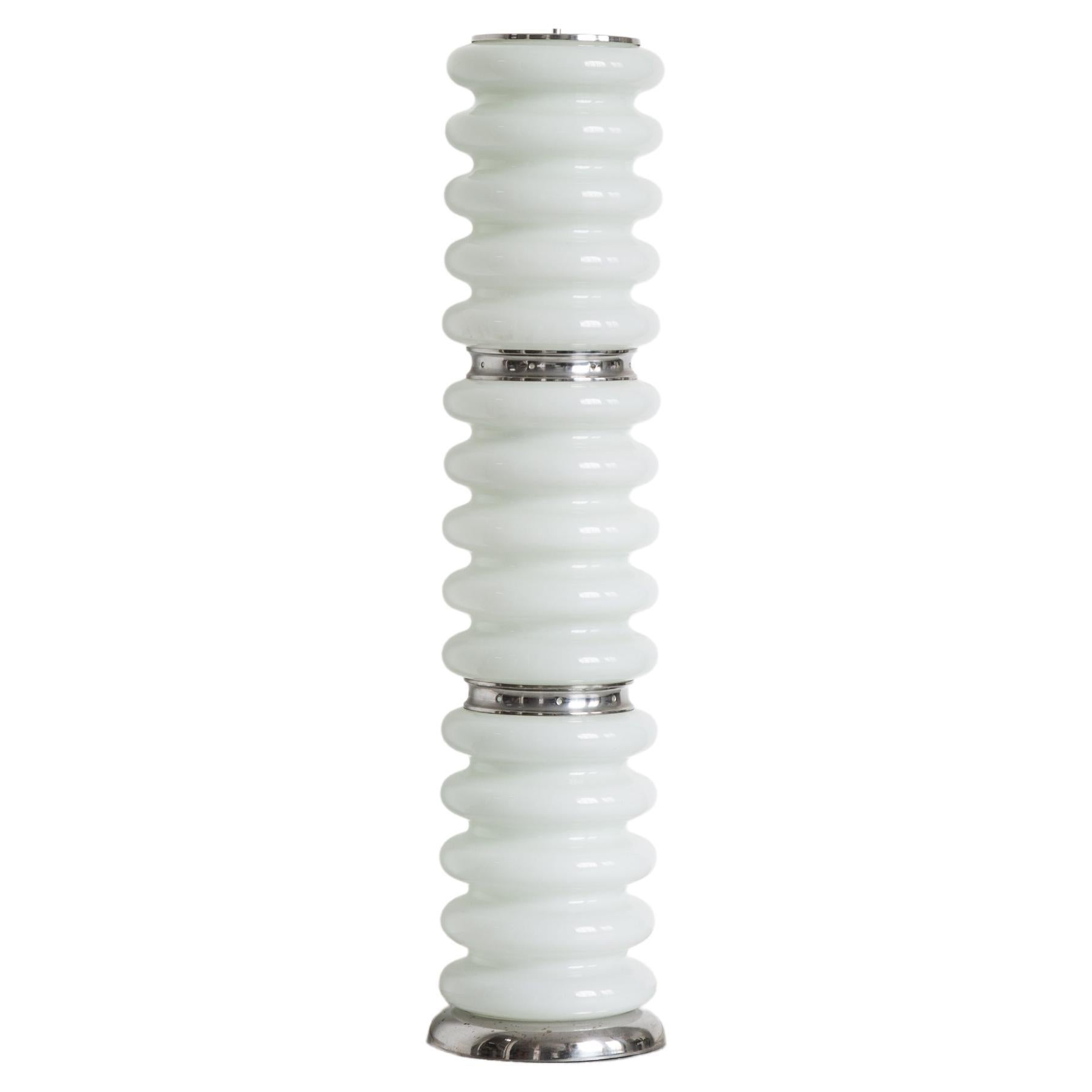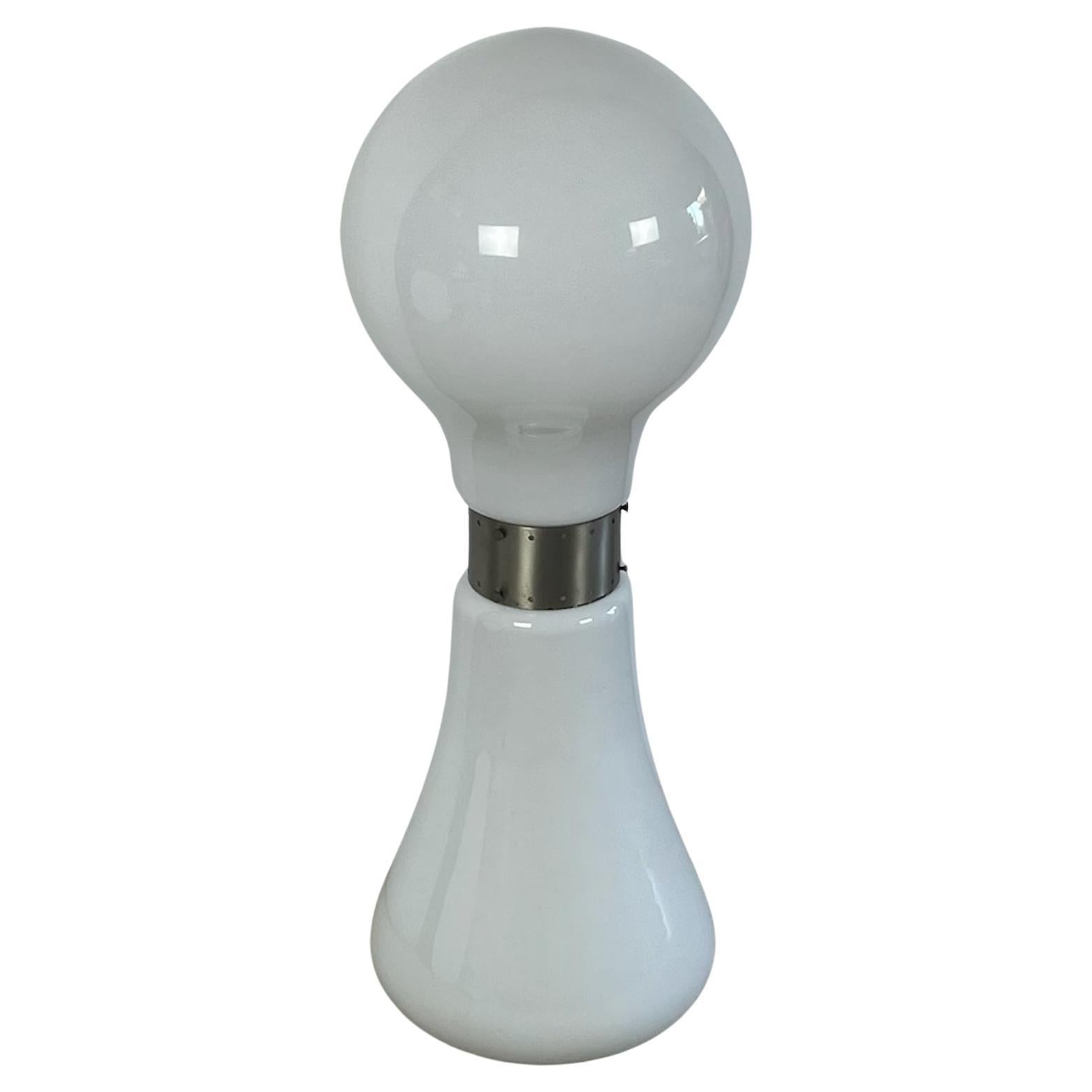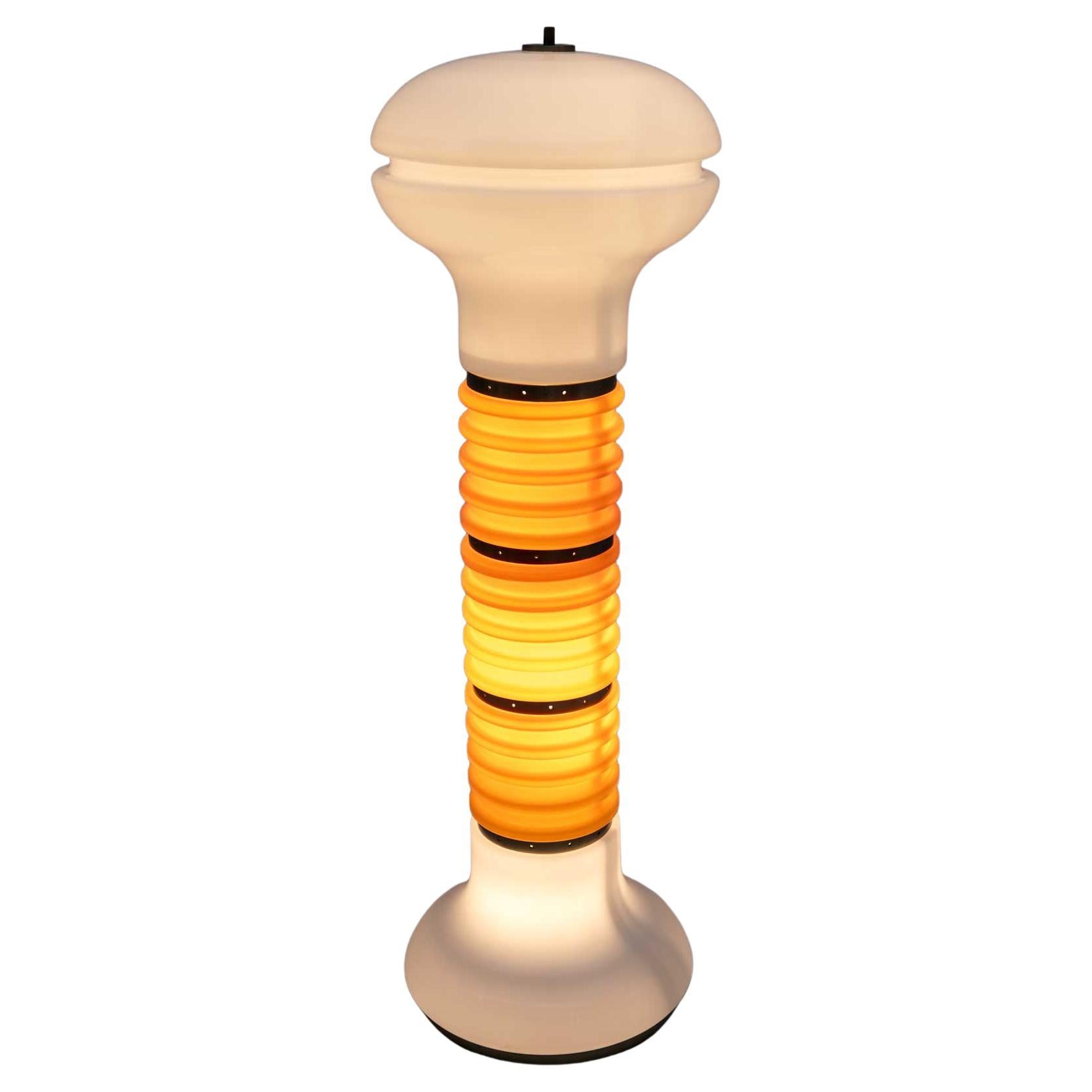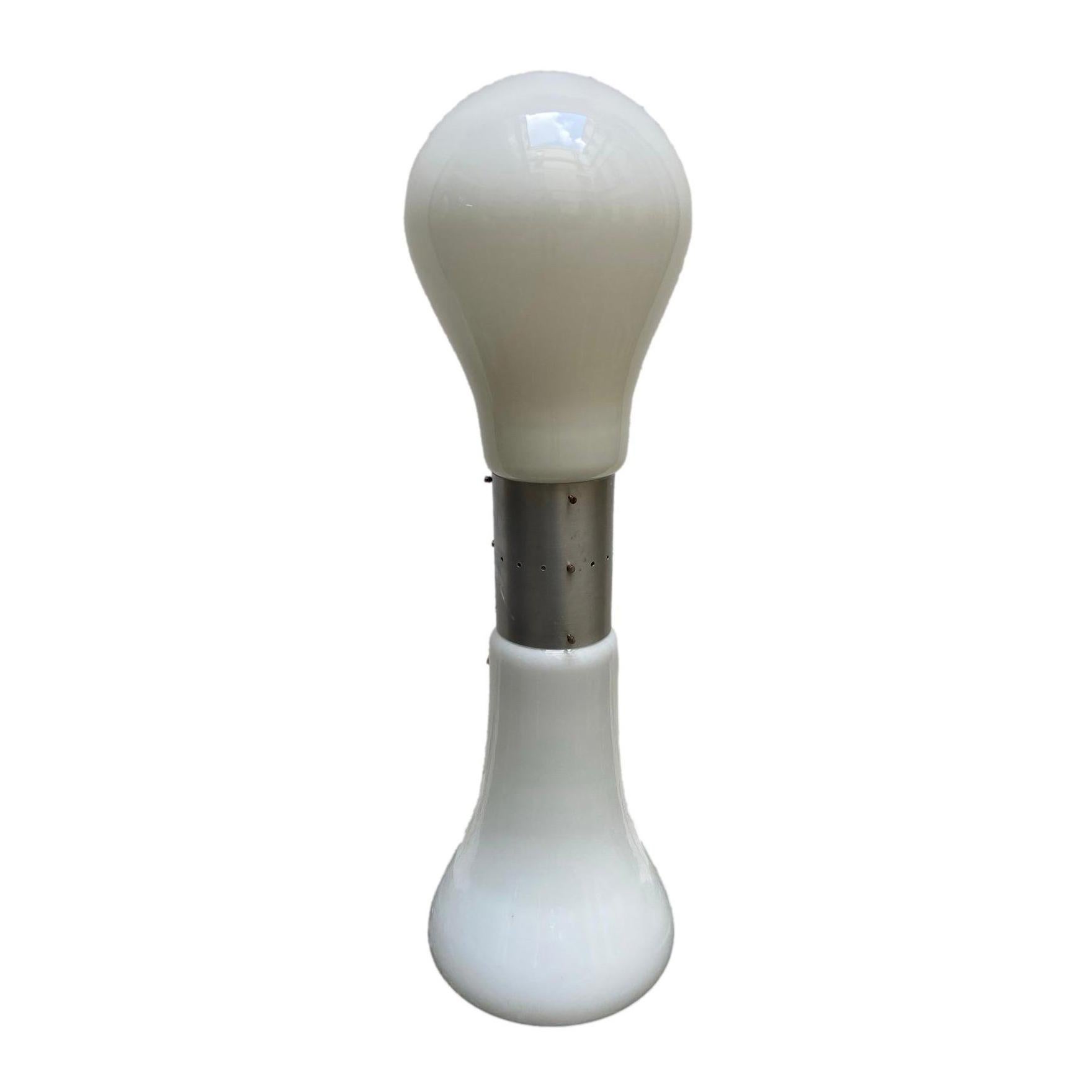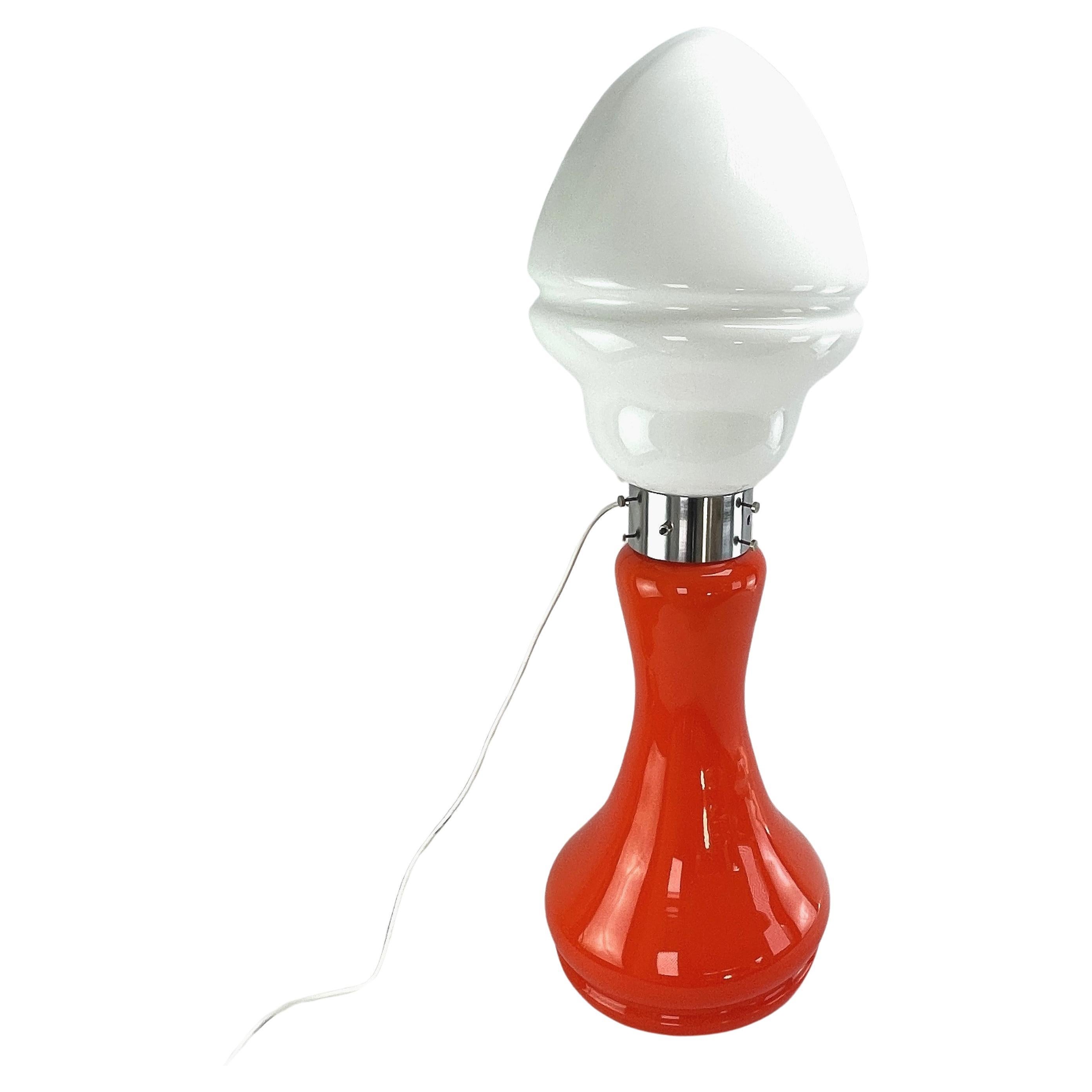Carlo Nason Space Age Opaline Murano Glass Birillo Floor Lamp for Mazzega, 1960s
About the Item
- Creator:Carlo Nason (Designer),Mazzega (Manufacturer)
- Dimensions:Height: 38.59 in (98 cm)Diameter: 13.78 in (35 cm)
- Power Source:Hardwired
- Voltage:220-240v
- Lampshade:Included
- Style:Space Age (Of the Period)
- Materials and Techniques:
- Place of Origin:
- Period:
- Date of Manufacture:1960s
- Condition:Minor fading.
- Seller Location:Vicenza, IT
- Reference Number:1stDibs: LU8019236384402
Carlo Nason
A mid-century modern reference for today’s Murano glassmakers, Carlo Nason influenced the current tradition of glassmaking on an island renowned for it for hundreds of years. Celebrated for their exceptional designs, Nason’s lighting fixtures are sought after by collectors worldwide.
Learning to design and craft pieces from the family vetreria — rather than partaking in any formal training — Nason was working with the maestros at his family’s company furnace, V. Nason & C., attached to their family home by the time he was 11 years old. Although his roots are in Murano glassmaking, he took inspiration from the clean lines and natural colors of the Japanese metal vases he had seen in his youth at Milanese fairs.
Wanting to produce modern glass lamps, Nason worked with his family friend Gianni Mazzega of Mazzega Murano. The 1970s and 1980s were productive and creative years for Nason as the sole and independent designer at Mazzega Murano. His prolific career has also seen him design for other lighting manufacturers like I TRE, Murano Due and Kalmar.
After a mere four years as a glassmaker, Carlo Nason had his creations displayed at the Corning Museum of Glass in New York. The credit for the artisan’s pieces that were included in “Glass 1959” went to his family’s company, but the designs were all authored by Carlo.
Stepping away from the traditional, vibrant Murano stylings, Nason kept true to his inspiration, working with modern and simple forms that are relatively free of color. Nason told Palainco in a rare 2019 interview that his emotions inspired the shapes. And his legacy includes fixtures that are irreplicable and unreproducible, too — Nason made lighting pieces with multiple layers of glass that would be too costly or difficult to recreate today, and some designs were made with processes and materials now unavailable or banned in the glassmaking world.
Find an array of vintage Carlo Nason table lamps, floor lamps, decorative objects and more on 1stDibs.
- ShippingRetrieving quote...Ships From: Costabissara, Italy
- Return PolicyA return for this item may be initiated within 14 days of delivery.
- Goffredo Reggiani Space Age Chrome Pipe 6 Arms Floor Lamp, Italy 1960sBy Gioffredo Reggiani, ReggianiLocated in Vicenza, ITThis floor lamp, designed by Goffredo Reggiani and produced by the Italian manufacturer “Reggiani Illuminazione” in the 60s, is the perfect choice to light up your Space Age living r...Category
Vintage 1960s Italian Mid-Century Modern Floor Lamps
MaterialsChrome
- Carlo Scarpa Green Poliedri Chandelier in Murano Opaline Glass for Venini, 1958By Carlo Scarpa, VeniniLocated in Vicenza, IT“Poliedri” chandelier designed by Carlo Scarpa and produced by the Italian manufacturer Venini in, 1958. Made of opaline Murano glass. Born in Venice on June 2nd, 1906, Carlo Scarpa began working at a very early age. Only a year after he had first qualified as an architect in 1926, he began working for the Murano glassmakers Cappellin & Co. in a consultative capacity; from 1927, he began to experiment with the Murano glass, and this research not only gave him excellent results here but would also inform his progress for many years to come. Between 1935 and 1937, as he entered his thirties, Carlo Scarpa accepted his first important commission, the renovation of Venice’s Cà Foscari. He adapted the spaces of this stately University building which stands on the banks of the Grand Canal, creating rooms for the Dean’s offices and a new hall for academic ceremonies; Mario Sironi and Mario De Luigi were charged with doing the restoration work on the frescos. After 1945, Carlo Scarpa found himself constantly busy with new commissions, including various furnishings and designs for the renovation of Venice’s Hotel Bauer and designing a tall building in Padua and a residential area in Feltre, which are all worth mention. One of his key works, despite its relatively modest diminished proportions, was the first of many works which were to follow in the nineteen fifties: the [bookshop known as the] Padiglione del Libro, which stands in Venice’s Giardini di Castello and shows clearly Scarpa’s passion for the works of Frank Lloyd Wright. In the years which were to follow, after he had met the American architect, Scarpa repeated similar experiments on other occasions, as can be seen, in particular, in the sketches he drew up in 1953 for villa Zoppas in Conegliano, which show some of his most promising work. However, this work unfortunately never came to fruition. Carlo Scarpa later created three museum layouts to prove pivotal in terms of how twentieth-century museums were to be set up from then on. Between 1955 and 1957, he completed extension work on Treviso’s Gipsoteca Canoviana [the museum that houses Canova’s sculptures] in Possagno, taking a similar experimental approach to the one he used for the Venezuelan Pavilion at [Venice’s] Giardini di Castello which he was building at the same time (1954-56). In Possagno Carlo Scarpa was to create one of his greatest ever works, which inevitably bears comparison with two other museum layouts that he was working on over the same period, those of the Galleria Nazionale di Sicilia, housed in the Palazzo Abatellis in Palermo (1953-55) and at the Castelvecchio in Verona (1957- 1974), all of which were highly acclaimed, adding to his growing fame. Two other buildings, which are beautifully arranged in spatial terms, can be added to this long list of key works that were started and, in some cases, even completed during the nineteen fifties. After winning the Olivetti award for architecture in 1956, Scarpa began work in Venice’s Piazza San Marco on an area destined to house products made by the Industrial manufacturers Ivrea. Over the same period (1959-1963), he also worked on renovation and restoration of the gardens and ground floor of the Fondazione Querini Stampalia in Venice, which many consider being one of his greatest works. While he busied himself working on-site at the Fondazione Querini Stampalia, Carlo Scarpa also began work building a villa in Udine for the Veritti family. To shed some light on the extent to which his work evolved over the years, it may perhaps be useful to compare this work with that of his very last building, villa Ottolenghi Bardolino, which was near to completion at the time of his sudden death in 1978. Upon completion of villa Veritti over the next ten years, without ever letting up on his work on renovation and layouts, Scarpa accepted some highly challenging commissions which were to make the most of his formal skills, working on the Carlo Felice Theatre in Genoa as well as another theatre in Vicenza. Towards the end of this decade, in 1969, Rina Brion commissioned Carlo Scarpa to build the Brion Mausoleum in San Vito d’Altivole (Treviso), a piece he continued to work on right up until the moment of his death. Nevertheless, even though he was totally absorbed by work on this mausoleum, there are plenty of other episodes which can offer some insight into the final years of his career. As work on the San Vito d’Altivole Mausoleum began to lessen from 1973, Carlo Scarpa began work building the new headquarters for the Banca Popolare di Verona. He drew up plans that were surprisingly different from the work he was carrying out at the same time on the villa Ottolenghi. However, the plans Carlo Scarpa drew up, at different times, for a monument in Brescia’s Piazza della Loggia commemorating victims of the terrorist attack on May 28th, 1974, make a sharp contrast to the work he carried out in Verona, almost as if there is a certain hesitation after so many mannered excesses. The same Pietas that informs his designs for the Piazza Della Loggia can also be seen in the presence of the water that flows through the Brion Mausoleum, almost as if to give a concrete manifestation of pity in this twentieth-century work of art. Carlo Scarpa has put together a highly sophisticated collection of structures, occupying the mausoleum’s L-shaped space stretching across both sides of the old San Vito d’Altivole cemetery. A myriad of different forms and an equally large number of different pieces, all of which are separate and yet inextricably linked to form a chain that seems to offer no promise of continuity, rising up out of these are those whose only justification for being there is to bear the warning “si vis vitam, para mortem”, [if you wish to experience life prepare for death] as if to tell a tale that suggests the circle of time, joining together the commemoration of the dead with a celebration of life. At the entrance of the Brion Mausoleum stand the “propylaea” followed by a cloister which ends by a small chapel, with an arcosolium bearing the family sarcophagi, the main pavilion, held in place on broken cast iron supports, stands over a mirror-shaped stretch of water and occupies one end of the family’s burial space. The musical sound of the walkways teamed with the luminosity of these harmoniously blended spaces shows how, in keeping with his strong sense of vision, Carlo Scarpa could make the most of all of his many skills to come up with this truly magnificent space. As well as a great commitment to architectural work, with the many projects which we have already seen punctuating his career, Carlo Scarpa also made many equally important forays into the world of applied arts. Between 1926 and 1931, he worked for the Murano glassmakers Cappellin, later taking what he had learned with him when he went to work for the glassmakers Venini from 1933 until the 1950s. The story of how he came to work on furniture design is different, however, and began with the furniture he designed to replace lost furnishings during his renovation of Cà Foscari. The later mass-produced furniture started differently, given that many pieces were originally one-off designs “made to measure”. Industrial manufacturing using these designs as prototypes came into being thanks to the continuity afforded him by Dino Gavina, who, as well as this, also invited Carlo Scarpa to become president of the company Gavina SpA, later to become SIMON, a company Gavina founded 8 years on, in partnership with Maria Simoncini (whose own name accounts for the choice of company name). Carlo Scarpa and Gavina forged a strong bond in 1968 as they began to put various models of his into production for Simon, such as the “Doge” table, which also formed the basis for the “Sarpi” and “Florian” tables. In the early seventies, other tables that followed included “Valmarana”, “Quatour” and “Orseolo”. While in 1974, they added couch and armchair “Cornaro” to the collection and the “Toledo” bed...Category
Vintage 1950s Italian Mid-Century Modern Chandeliers and Pendants
MaterialsGlass, Murano Glass
- Carlo Scarpa Big “Poliedri” Chandelier in Murano Opaline Glass for Venini, 1958By Carlo Scarpa, VeniniLocated in Vicenza, IT“Poliedri” chandelier designed by Carlo Scarpa and produced by the Italian manufacturer Venini in, 1958. Made of opaline Murano glass. Born in Venice on June 2nd, 1906, Carlo Scarpa began working at a very early age. Only a year after he had first qualified as an architect in 1926, he began working for the Murano glassmakers Cappellin & Co. in a consultative capacity; from 1927, he began to experiment with the Murano glass, and this research not only gave him excellent results here but would also inform his progress for many years to come. Between 1935 and 1937, as he entered his thirties, Carlo Scarpa accepted his first important commission, the renovation of Venice’s Cà Foscari. He adapted the spaces of this stately University building which stands on the banks of the Grand Canal, creating rooms for the Dean’s offices and a new hall for academic ceremonies; Mario Sironi and Mario De Luigi were charged with doing the restoration work on the frescos. After 1945, Carlo Scarpa found himself constantly busy with new commissions, including various furnishings and designs for the renovation of Venice’s Hotel Bauer and designing a tall building in Padua and a residential area in Feltre, which are all worth mention. One of his key works, despite its relatively modest diminished proportions, was the first of many works which were to follow in the nineteen fifties: the [bookshop known as the] Padiglione del Libro, which stands in Venice’s Giardini di Castello and shows clearly Scarpa’s passion for the works of Frank Lloyd Wright. In the years which were to follow, after he had met the American architect, Scarpa repeated similar experiments on other occasions, as can be seen, in particular, in the sketches he drew up in 1953 for villa Zoppas in Conegliano, which show some of his most promising work. However, this work unfortunately never came to fruition. Carlo Scarpa later created three museum layouts to prove pivotal in terms of how twentieth-century museums were to be set up from then on. Between 1955 and 1957, he completed extension work on Treviso’s Gipsoteca Canoviana [the museum that houses Canova’s sculptures] in Possagno, taking a similar experimental approach to the one he used for the Venezuelan Pavilion at [Venice’s] Giardini di Castello which he was building at the same time (1954-56). In Possagno Carlo Scarpa was to create one of his greatest ever works, which inevitably bears comparison with two other museum layouts that he was working on over the same period, those of the Galleria Nazionale di Sicilia, housed in the Palazzo Abatellis in Palermo (1953-55) and at the Castelvecchio in Verona (1957- 1974), all of which were highly acclaimed, adding to his growing fame. Two other buildings, which are beautifully arranged in spatial terms, can be added to this long list of key works that were started and, in some cases, even completed during the nineteen fifties. After winning the Olivetti award for architecture in 1956, Scarpa began work in Venice’s Piazza San Marco on an area destined to house products made by the Industrial manufacturers Ivrea. Over the same period (1959-1963), he also worked on renovation and restoration of the gardens and ground floor of the Fondazione Querini Stampalia in Venice, which many consider being one of his greatest works. While he busied himself working on-site at the Fondazione Querini Stampalia, Carlo Scarpa also began work building a villa in Udine for the Veritti family. To shed some light on the extent to which his work evolved over the years, it may perhaps be useful to compare this work with that of his very last building, villa Ottolenghi Bardolino, which was near to completion at the time of his sudden death in 1978. Upon completion of villa Veritti over the next ten years, without ever letting up on his work on renovation and layouts, Scarpa accepted some highly challenging commissions which were to make the most of his formal skills, working on the Carlo Felice Theatre in Genoa as well as another theatre in Vicenza. Towards the end of this decade, in 1969, Rina Brion commissioned Carlo Scarpa to build the Brion Mausoleum in San Vito d’Altivole (Treviso), a piece he continued to work on right up until the moment of his death. Nevertheless, even though he was totally absorbed by work on this mausoleum, there are plenty of other episodes which can offer some insight into the final years of his career. As work on the San Vito d’Altivole Mausoleum began to lessen from 1973, Carlo Scarpa began work building the new headquarters for the Banca Popolare di Verona. He drew up plans that were surprisingly different from the work he was carrying out at the same time on the villa Ottolenghi. However, the plans Carlo Scarpa drew up, at different times, for a monument in Brescia’s Piazza della Loggia commemorating victims of the terrorist attack on May 28th, 1974, make a sharp contrast to the work he carried out in Verona, almost as if there is a certain hesitation after so many mannered excesses. The same Pietas that informs his designs for the Piazza Della Loggia can also be seen in the presence of the water that flows through the Brion Mausoleum, almost as if to give a concrete manifestation of pity in this twentieth-century work of art. Carlo Scarpa has put together a highly sophisticated collection of structures, occupying the mausoleum’s L-shaped space stretching across both sides of the old San Vito d’Altivole cemetery. A myriad of different forms and an equally large number of different pieces, all of which are separate and yet inextricably linked to form a chain that seems to offer no promise of continuity, rising up out of these are those whose only justification for being there is to bear the warning “si vis vitam, para mortem”, [if you wish to experience life prepare for death] as if to tell a tale that suggests the circle of time, joining together the commemoration of the dead with a celebration of life. At the entrance of the Brion Mausoleum stand the “propylaea” followed by a cloister which ends by a small chapel, with an arcosolium bearing the family sarcophagi, the main pavilion, held in place on broken cast iron supports, stands over a mirror-shaped stretch of water and occupies one end of the family’s burial space. The musical sound of the walkways teamed with the luminosity of these harmoniously blended spaces shows how, in keeping with his strong sense of vision, Carlo Scarpa could make the most of all of his many skills to come up with this truly magnificent space. As well as a great commitment to architectural work, with the many projects which we have already seen punctuating his career, Carlo Scarpa also made many equally important forays into the world of applied arts. Between 1926 and 1931, he worked for the Murano glassmakers Cappellin, later taking what he had learned with him when he went to work for the glassmakers Venini from 1933 until the 1950s. The story of how he came to work on furniture design is different, however, and began with the furniture he designed to replace lost furnishings during his renovation of Cà Foscari. The later mass-produced furniture started differently, given that many pieces were originally one-off designs “made to measure”. Industrial manufacturing using these designs as prototypes came into being thanks to the continuity afforded him by Dino Gavina, who, as well as this, also invited Carlo Scarpa to become president of the company Gavina SpA, later to become SIMON, a company Gavina founded 8 years on, in partnership with Maria Simoncini (whose own name accounts for the choice of company name). Carlo Scarpa and Gavina forged a strong bond in 1968 as they began to put various models of his into production for Simon, such as the “Doge” table, which also formed the basis for the “Sarpi” and “Florian” tables. In the early seventies, other tables that followed included “Valmarana”, “Quatour” and “Orseolo”. While in 1974, they added couch and armchair “Cornaro” to the collection and the “Toledo” bed...Category
Vintage 1950s Italian Mid-Century Modern Chandeliers and Pendants
MaterialsGlass, Murano Glass
- Tommaso Barbi Midcentury Leaf Floor Lamp in Brass for Bottega Gadda, 1970By Tommaso Barbi, Bottega GaddaLocated in Vicenza, ITThe leaf Floor lamp is a masterpiece designed in 1970 by Tommaso Barbi. Experience the allure of the Leaf Floor Lamp, a true work of art crafted by renowned Italian manufacturer Bot...Category
Vintage 1970s Italian Mid-Century Modern Floor Lamps
MaterialsBrass
- Eero Saarinen Space Age White Carrara Marble Tulip Table for Knoll, 1967By Knoll, Eero SaarinenLocated in Vicenza, ITTulip round dining table designed by Eero Saarinen in 1957 and manufactured by Knoll in 1967. Composed of a white lacquered pedestal and a tabletop...Category
Vintage 1960s Italian Space Age Dining Room Tables
MaterialsCarrara Marble
- Eero Saarinen Space Age Marble Tulip Nightstand for Knoll, 1967, Set of 2By Knoll, Eero SaarinenLocated in Vicenza, ITPair of Tulip Night Stands designed by Eero Saarinen in 1957 and manufactured by Knoll in 1967. Composed of a white lacquered pedestal and a tabletop made of Carrara Arabescato marb...Category
Vintage 1960s Italian Space Age Night Stands
MaterialsCarrara Marble
- Vintage Space Age Murano floor lamp by Carlo Nason for Mazzega, opaline glassBy Mazzega, Carlo NasonLocated in Milano, ITBorn in 1935 into a family of celebrated glassmakers from the venetian island of Murano, Carlo Nason is no doubt one of the most influential glass designers of the twentieth century....Category
Vintage 1960s Italian Space Age Floor Lamps
MaterialsSteel, Chrome
- Birillo Floor Lamp in Opaline Glass by Carlo Nason for Mazzega, 1970sBy Mazzega, Carlo NasonLocated in San Benedetto Del Tronto, ITBeautiful and iconic space age floor lamp ‘Birillo’ designed by Carlo Nason for Mazzega in the 70s. This awesome lamp with the iconic ‘pin’ shape is made of two symmetric lampshades...Category
Vintage 1970s Italian Space Age Floor Lamps
MaterialsMetal
- Carlo Nason Italian Murano Glass Floor Lamp "Birillo" for Mazzega, 1970sBy Mazzega, Carlo NasonLocated in Puglia, Puglia"Birillo" Murano glass floor lamp, designed by Carlo Nason for Mazzega, 1970s. The lamp consists of 5 glass parts supported by a metal fixing rod in the center, which holds the glas...Category
Vintage 1970s Italian Mid-Century Modern Floor Lamps
MaterialsMurano Glass
- Birillo Murano Glass Floor Lamp by Carlo Nason for Mazzega, Italy, 1960sBy AVMazzega, Carlo NasonLocated in Miklavž Pri Taboru, SIThe Birillo floor lamp was designed by Carlo Nason for Mazzega, in Italy, during the 1960s. It has two large white Murano Blown Glasses, with green sparkles. The chrome belt has two ...Category
Mid-20th Century Italian Mid-Century Modern Floor Lamps
MaterialsMetal
- Carlo Nason for Mazzega White Murano Glass Floor Lamp, Italy, 1960sBy Mazzega, Carlo NasonLocated in Naples, ITIconic 60s floor lamp composed of two large white blown and jacketed glass diffusers held together by a stainless steel bracelet. When switched on, bo...Category
Vintage 1960s Italian Mid-Century Modern Floor Lamps
MaterialsChrome
- Carlo Nason, A. V. Mazzega, orange "Birillo" Lipstick , Glass, Chrome, 1960sBy Mazzega, Carlo NasonLocated in Saarburg, RPThe floor lamp by Carlo Nason for Mazzega The Lipstick floor lamp by Carlo Nason for Mazzega is an elegant and timeless piece of lighting that will enchant any room with its sophist...Category
Vintage 1960s Italian Mid-Century Modern Floor Lamps
MaterialsMetal
